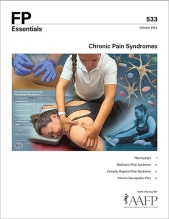
This clinical content conforms to AAFP criteria for CME.
Fibromyalgia is a chronic pain syndrome that is considered a pain processing disorder; its pathophysiology is not completely understood. The estimated prevalence in the general population varies from 0.5% to 12%, depending on the population studied and diagnostic criteria used. It is more common in females than males. There is no diagnostic laboratory test. The two currently used diagnostic methods are scoring criteria from the American College of Rheumatology (ACR) and the Analgesic, Anesthetic, and Addiction Clinical Trial Translations Innovations Opportunities and Networks (ACTTION)-American Pain Society (APS). These diagnostic criteria include chronic widespread pain of at least 3 months’ duration plus poor sleep and/or fatigue and other somatic symptoms. Other pain syndromes also should be considered in the differential diagnosis. A multimodal, targeted symptom management approach that emphasizes self-management is recommended. Nonpharmacotherapies include patient education, exercise, and cognitive behavior therapy. Pharmacotherapy should be based on predominant symptoms. Amitriptyline and pregabalin are effective for management of pain, fatigue, and sleep issues. Milnacipran (Savella) is effective for pain and fatigue. Duloxetine is effective for management of pain and depression. There is no evidence of benefit of analgesics. Common comorbidities, such as regional pain conditions and mental disorders, should be addressed.
Case 1. SB is a 31-year-old patient with a 3-year history of generalized achiness in various muscles and joints. She comes to your office for a physical examination. A review of systems identifies fatigue, poor sleep, slow cognitive responses, and migraines. The physical examination results are normal except for generalized tenderness. You suspect fibromyalgia. You fill out a diagnostic criteria checklist for fibromyalgia and determine that SB’s symptoms are consistent with this condition. You provide SB with a patient education handout. You also prescribe low-dose amitriptyline (10 mg/day) with a plan to gradually increase the dosage. To rule out other conditions, you obtain a comprehensive metabolic panel, complete blood cell count, and C-reactive protein and thyrotropin levels. You ask SB to schedule a follow-up visit in 4 weeks.
Subscribe
From $350- Immediate, unlimited access to FP Essentials content
- 60 CME credits/year
- AAFP app access
- Print delivery available
Edition Access
$44- Immediate, unlimited access to this edition's content
- 5 CME credits
- AAFP app access
- Print delivery available
